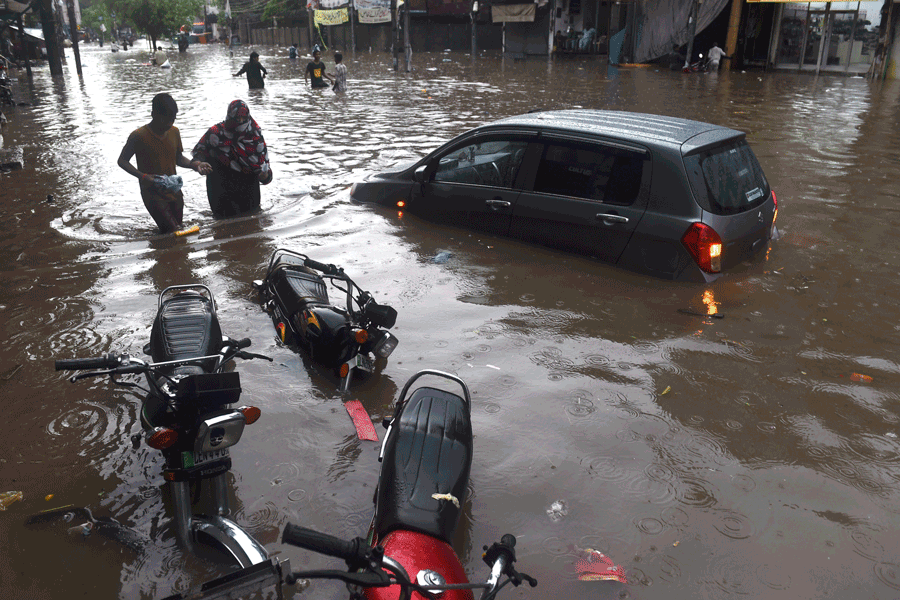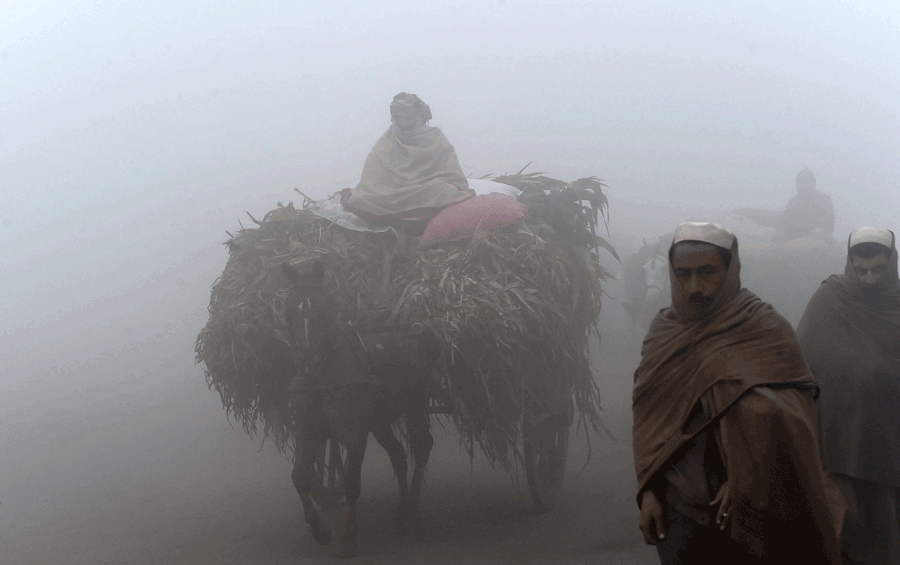A Climate of Change
By Rina Saeed Khan | Environment | Published 6 years ago
Pakistan is currently facing the devastating consequences of climate change – recurring floods, unforeseen droughts, deadly heat waves, erratic rainfall, melting glaciers, glacial lake outbursts. Mountain and coastal communities are among those most vulnerable to the dangers of climate change. Many residents of Pakistan’s coastal areas have migrated due to rising sea levels.
Of late, the local news has been full of reports of destructive glacier floods in the remote valleys of Chitral that have washed away homes and orchards. At the same time, there are also reports of the long march of the residents of villages of Thatta, who are protesting against the demise of the Indus Delta. It has been estimated that in the last few decades, nearly 1.5 million people have migrated from the coastline due to a lack of freshwater in the Indus and the intrusion of seawater into the delta.

Pakistani residents wade along a flooded street after heavy monsoon rains in Lahore, on July 16, 2019.
Pakistan ranks 8th on the Germanwatch annual report, The Long-Term Climate Risk Index: 10 countries most affected from 1998 to 2017, from climate related disasters. The report states that Pakistan has suffered 145 disasters, the loss of 512 lives and US$ 3,826 million, over a 20-year period. While the villagers in the north and south of the country are the most exposed to climate change, its impacts can also be felt across the agricultural plains, which are Pakistan’s breadbasket.
“Erratic rainfall, heatwaves and floods have all wreaked havoc on my crops in recent years,” says Aamer Hayat Bhandara, a farmer from central Punjab, the most fertile province of Pakistan. With its arable land and freshwater from glacier-fed rivers, Pakistan is one of the world’s largest producers and suppliers of food and crops. Bhandara, who has been farming for 15 years, says, “Agriculture is the most important victim of climate change and in Pakistan, farmers are surely affected by its impacts.” In his opinion, “there is no credible policy on the part of the government, to provide information to farmers in the context of weather updates, low-cost adaptation strategies and provision of heat-tolerant, or drought-resistant seeds.”
The Special Advisor to the Prime Minister on Climate Change, Malik Amin Aslam, has admitted that agriculture is a neglected sector in Pakistan. While announcing a six-year project titled Transforming the Indus Basin with Climate Resilient Agriculture and Water Management, due to start in two to three months’ time, he said, “Farmers can’t wait any more, they have to adapt immediately to a changing climate.”
The project will focus on small farmers who till less than a hectare of land and have been badly hit by climate change. The Ministry of Climate Change will be implementing it, along with the Food and Agriculture Organisation (FAO), in eight districts of Pakistan – three in Sindh and five in southern Punjab – through a $35 million grant from Green Climate Fund (GCF), the financial mechanism of the United Nations Framework Convention on Climate Change (UNFCCC).
According to Aslam, the project “Will ensure that these farmers get the right information at the right time, about when to plant and harvest crops. Under the project, meteorological stations will be set up in these districts, which will provide weather information to the farmers.” He added that “through Farmer Field Schools and agricultural extension services, they will be taught how to plant better and with less water. The plan is to learn innovative practices from this pilot project, which will then be upscaled.”
Prime Minister Imran Khan has noted the urgency of climate change in several speeches to the nation and was responsible for conceiving the successful Billion Tree Tsunami Afforestation Project, implemented on the ground by Aslam in Khyber Pakhtunkwa (KP) over the last five years.

A man rides on a loaded horse-cart amid heavy smog conditions.
Sixty per cent of the billion trees grew as a result of the protection of forests and natural habitats, while 40 per cent were planted anew by local residents, with the help of the Forest Department. “This self-financed project created half-a-million green jobs, revived forest biodiversity, engaged the local communities and energised the youth to become custodians of a green future,” said Aslam.
Now, the PM is spearheading a nationwide 10 Billion Tree Project, to mitigate the effects of climate change. It envisions the protection of forests and planting of trees in all four provinces. According to Aslam, the new government is now working on shifting towards climate-resilient agriculture, investing in renewable energy as well as introducing an initiative to utilise floodwaters for ecosystem restoration and groundwater recharge. He said, “This low-carbon economy is the only solution we have to climate change and in Pakistan we are responsibly steering the country towards this green growth.”
Tackling climate change by planting trees and shifting to renewable energy would also help clear-up air pollution in Pakistan’s cities. According to WWF-Pakistan’s Director General, Hammad Naqi Khan, “Lahore and Karachi are among the 10 most polluted cities in the world, in terms of air quality.”
He pointed out that air pollution is caused by traffic, industries and the burning of crops and solid waste, which are all major contributors to the winter smog. In his opinion, “Urban air pollution in Pakistan is among the world’s most severe, significantly damaging human health, quality of life, economy and the environment.”
Islamabad, the green capital city of Pakistan, may appear to be cleaner than the other cities, but it has just about as many clean air days as Karachi, which is only saved by its sea breeze that takes the air pollution out to sea, according to Abid Omar, the founder of Pakistan Air Quality Initiative, in Karachi. The non-profit organisation publishes data on air pollution and information about its effects on human health. Omar started it in 2016, because there was an alarming lack of data on air pollution levels in Pakistan back then. “There is coal, oil, biomass, diesel and petrol in the air we breathe,” he says. “It enters our lungs and is absorbed into our bloodstream and causes diseases affecting our heart and lungs.”
A groundbreaking report released by the International Centre for Integrated Mountain Development (ICIMOD) this year – its first Hindu Kush Himalaya (HKH) Assessment Report – noted that there has been a rapid rise in air pollution affecting the mountain belt in the past two decades. According to the report, “Thick aerosol haze covers the heavily populated Indo-Gangetic Plains during the dry season, reducing visibility and obscuring sunlight. The haze often penetrates deep into Himalayan valleys, reaching the high mountains.” Snow and glacier melt are accelerated by absorbing aerosols including black carbon and dust from the smog, says the report. The aerosols could also be “affecting shifts in rainfall dynamics”. Pakistan is entirely dependent on the Indus River, which is fed by both glacier melt and rainfall for its freshwater, so air pollution in urban centres has far-reaching effects.
Smog is a serious problem in the whole of Pakistan. To properly tackle the smog, we need more studies to identify the major sources of pollution. According to Omar, “We don’t really know the exact composition of the smog. We need comprehensive monitoring, research and evaluation.”
Aslam, meanwhile, contends that his government has re-started monitoring the air quality in Lahore – a practice that the previous government had discontinued. “Although much more needs to be done to expand the monitoring stations and enhance the credibility of data, this is certainly a step in the right direction,” he says.
Pakistan also uses the most polluted fuel in the world and tackling this problem will require a tremendous change in the energy and transport sectors. Aslam admits that vehicular emission is a problem. “We are looking into moving from the Euro 2 standards in Pakistan right now, to the cleaner Euro 5 (European emission standards for road vehicles set in order to define acceptable levels of exhaust emissions),” he says. “But petrol will become even more expensive for consumers as a result.” A month ago, the PM ordered the Ministry of Climate Change to formulate a National Electric Vehicle Policy, to be presented to the Cabinet for final approval. The policy aims for a 30-50 per cent penetration of new electric vehicles by 2030 and a whopping 90 per cent by 2040.
Amin Aslam says it is “important to get things going on the ground… PTI was the first political party to start thinking about climate change. The PM talked about it in his first address to the nation, so we do want to translate it into action”. However, the Climate Change Act 2017 is yet to be implemented. The Climate Change Council has not met and the Climate Change Authority’s posts are yet to be filled. The challenge is immense and the clock is ticking.


